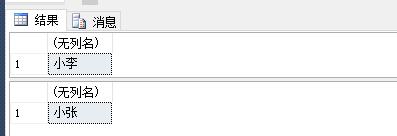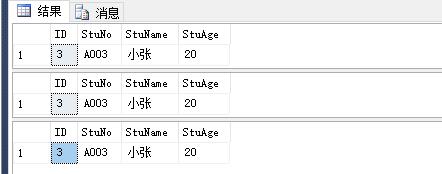SQL Server CLR 使用 C# 自定义存储过程和触发器
资源来源:https://www.cnblogs.com/Brambling/p/8016060.html
SQL Server CLR 使用 C# 自定义存储过程和触发器
这一篇博客接着上一篇博客继续介绍 SQL CLR Stored Procedure 和 CLR Trigger,
上一篇博客介绍了 SQL CLR Function 的使用,以及 CLR 程序集的注册和 CLR Function 的注册。
我的上一篇博客:SQL Server CLR 使用 C# 自定义函数
四、CLR Stored Procedure
接下来在之前的项目选择添加新项,选择 SQL CLR C# 存储过程。

public partial class StoredProcedures
{
/// <summary>
/// 无输入参数,无输出参数,无输出结果,有输出消息,无返回值的存储过程
/// </summary>
[Microsoft.SqlServer.Server.SqlProcedure(Name = "HelloWorld")]
public static void HelloWorld()
{
SqlContext.Pipe.Send("Hello World");
} /// <summary>
/// 有输入参数,无输出参数,无输出结果,无输出消息,有返回值的存储过程
/// </summary>
/// <param name="name"></param>
[Microsoft.SqlServer.Server.SqlProcedure(Name = "GetStrLength")]
public static SqlInt32 GetStrLength(SqlString str)
{
return str.ToString().Length;
} /// <summary>
/// 有输入参数,有输出参数,无输出结果,无输出消息,无返回值的存储过程
/// </summary>
/// <param name="name"></param>
[Microsoft.SqlServer.Server.SqlProcedure(Name = "SayHello")]
public static void SayHello(SqlString name,out SqlString sayHello)
{
sayHello = "Hello " + name.ToString();
}
}

注册程序集和注册存储过程的 SQL 后面再贴出来,这里我们先看看结果。
PS:如果你用的是 Visual Studio 2015,那么你可以在【项目路径>obj>Debug】文件夹下面找到自动生成的注册程序集和存储过程的 SQL 语句。至于其他版本大家可以试试。
执行存储过程 HelloWorld:
--执行存储过程 HelloWorld
exec [dbo].[HelloWorld]
结果:

这就是输出消息,输出消息和输出结果是不一样的,输出消息是没办法获取的(我没办法),而输出结果就相当于用 Select 语句查询出来的结果一样,是可以获取的。
执行存储过程 GetStrLength:
--执行存储过程 GetStrLength
declare @res int
exec @res=[dbo].[GetStrLength] '123456'
select @res
结果:

这个 C# 代码里面是有返回值的,也可以通过这种方式获取到返回值,但是这种返回值的方式只能返回 int 类型的返回值。
如果需要多个返回值呢?看下面的存储过程,可以通过设置多个输出参数来达到。
执行存储过程 SayHello:
--执行存储过程 SayHello
declare @SayHello nvarchar(32)
exec [dbo].[SayHello] 'Brambling',@SayHello output select @SayHello
结果:

其实弄明白输入参数、输出参数、输出消息、输出结果和返回值这几个问题,CLR 存储过程的介绍就可以完了。
但是存储过程里面总是免不了要操作数据的,那么下面就看看对于数据库数据的操作和输出结果集的方法吧。

/// <summary>
/// 根据学生学号获取学生姓名
/// </summary>
/// <param name="Id"></param>
/// <returns></returns>
[Microsoft.SqlServer.Server.SqlProcedure(Name = "GetStudentNameByStuNo")]
public static void GetStudentNameByStuNo(SqlString stuNo,out SqlString stoName)
{
stoName = string.Empty; //因为程序是在SQL Server内执行,所以连接字符串写成"context connection=true"即可
using (SqlConnection conn = new SqlConnection("context connection=true"))
{
SqlCommand comm = new SqlCommand();
comm.CommandText = "select StuName from StudentInfo where StuNo=@StuNo;"; SqlParameter param = new SqlParameter("@StuNo", SqlDbType.NVarChar, 4000);
param.SqlValue = stuNo;
comm.Parameters.Add(param); comm.Connection = conn;
conn.Open();
SqlDataReader dataReader = comm.ExecuteReader();
if (dataReader.Read())
{
stoName = dataReader.GetString(0);
}
dataReader.Close();
}
}

执行存储过程 GetStudentNameByStuNo:
declare @StuName nvarchar(32)
exec [GetStudentNameByStuNo] 'A001',@StuName output
select @StuName
exec [GetStudentNameByStuNo] 'A003',@StuName output
select @StuName
结果:

可以看到我们通过输出参数获取到了返回值。如果现在我需要获取整个学生的所有信息呢?
虽然可以通过设置多个输出参数得到,但是学生信息的字段过多呢?下面看看输出结果集的方式。

/// <summary>
/// 根据学生的学号获取该学生的所有信息
/// 返回的是一个结果集,即有多少条数据就返回多少条数据
/// </summary>
/// <param name="stuNo"></param>
[Microsoft.SqlServer.Server.SqlProcedure(Name = "GetStudentInfoByStuNo_First")]
public static void GetStudentInfoByStuNo_First(SqlString stuNo)
{
using (SqlConnection conn = new SqlConnection("context connection=true"))
{
SqlCommand comm = new SqlCommand();
comm.CommandText = "select ID,StuNo,StuName,StuAge from StudentInfo where StuNo=@StuNo;"; SqlParameter param = new SqlParameter("@StuNo", SqlDbType.NVarChar, 4000);
param.SqlValue = stuNo;
comm.Parameters.Add(param); comm.Connection = conn;
conn.Open();
SqlDataReader dataReader = comm.ExecuteReader();
SqlContext.Pipe.Send(dataReader);
dataReader.Close();
}
} /// <summary>
/// 根据学生的学号获取该学生的所有信息
/// 这种方式效率比较高,是通过直接执行 SqlCommand 指令,然后把数据发送到客户端,不需要经过托管内存
/// </summary>
/// <param name="stuNo"></param>
[Microsoft.SqlServer.Server.SqlProcedure(Name = "GetStudentInfoByStuNo_Second")]
public static void GetStudentInfoByStuNo_Second(SqlString stuNo)
{
using (SqlConnection conn = new SqlConnection("context connection=true"))
{
SqlCommand comm = new SqlCommand();
comm.CommandText = "select ID,StuNo,StuName,StuAge from StudentInfo where StuNo=@StuNo;"; SqlParameter param = new SqlParameter("@StuNo", SqlDbType.NVarChar, 4000);
param.SqlValue = stuNo;
comm.Parameters.Add(param); comm.Connection = conn;
conn.Open();
SqlContext.Pipe.ExecuteAndSend(comm);
}
} /// <summary>
/// 根据学生的学号获取该学生的所有信息
/// </summary>
/// <param name="stuNo"></param>
[Microsoft.SqlServer.Server.SqlProcedure(Name = "GetStudentInfoByStuNo_Third")]
public static void GetStudentInfoByStuNo_Third(SqlString stuNo)
{
using (SqlConnection conn = new SqlConnection("context connection=true"))
{
SqlCommand comm = new SqlCommand();
comm.CommandText = "select ID,StuNo,StuName,StuAge from StudentInfo where StuNo=@StuNo;"; SqlParameter param = new SqlParameter("@StuNo", SqlDbType.NVarChar, 4000);
param.SqlValue = stuNo;
comm.Parameters.Add(param); comm.Connection = conn;
conn.Open();
SqlDataReader dataReader = comm.ExecuteReader(); SqlDataRecord dataRecord = new SqlDataRecord(
new SqlMetaData[]
{
new SqlMetaData("ID",SqlDbType.Int),
new SqlMetaData("StuNo",SqlDbType.NVarChar,128),
new SqlMetaData("StuName",SqlDbType.NVarChar,128),
new SqlMetaData("StuAge",SqlDbType.Int)
}
); if(dataReader.Read())
{
dataRecord.SetInt32(0,(int)dataReader["ID"]);
dataRecord.SetString(1,(string)dataReader["StuNo"]);
dataRecord.SetString(2,(string)dataReader["StuName"]);
dataRecord.SetInt32(3,(int)dataReader["StuAge"]);
SqlContext.Pipe.Send(dataRecord);
}
dataReader.Close();
}
}

执行存储过程:

--执行存储过程 GetStudentInfoByStuNo_First
exec [GetStudentInfoByStuNo_First] 'A003' --执行存储过程 GetStudentInfoByStuNo_Second
exec [GetStudentInfoByStuNo_Second] 'A003' --执行存储过程 GetStudentInfoByStuNo_Third
exec [GetStudentInfoByStuNo_Third] 'A003'

结果:

上面三个方法中,第一个方法和第二个方法都是直接返回查询结果的,但是在实际存储过程当中是不会这样写的,里面应该包含有逻辑操作等等,所以就有了第三个方法。
那么现在是返回的一条数据,如果是返回多条数据呢?第一种方法和第二种方法就不说了,因为这两种方法都是返回结果集的。

/// <summary>
/// 根据年龄查询学生的信息
/// 这种方式是一条数据返回一个结果集
/// </summary>
/// <param name="stuAge"></param>
[Microsoft.SqlServer.Server.SqlProcedure(Name = "GetStudentsInfoByStuAge_Single")]
public static void GetStudentsInfoByStuAge_Single(SqlInt32 stuAge)
{
using (SqlConnection conn = new SqlConnection("context connection=true"))
{
SqlCommand comm = new SqlCommand();
comm.CommandText = "select ID,StuNo,StuName,StuAge from StudentInfo where StuAge=@StuAge;"; SqlParameter param = new SqlParameter("@StuAge", SqlDbType.Int);
param.SqlValue = stuAge;
comm.Parameters.Add(param); comm.Connection = conn;
conn.Open();
SqlDataReader dataReader = comm.ExecuteReader(); SqlDataRecord dataRecord = new SqlDataRecord(
new SqlMetaData[]
{
new SqlMetaData("ID",SqlDbType.Int),
new SqlMetaData("StuNo",SqlDbType.NVarChar,128),
new SqlMetaData("StuName",SqlDbType.NVarChar,128),
new SqlMetaData("StuAge",SqlDbType.Int)
}
); while (dataReader.Read())
{
dataRecord.SetInt32(0, (int)dataReader["ID"]);
dataRecord.SetString(1, (string)dataReader["StuNo"]);
dataRecord.SetString(2, (string)dataReader["StuName"]);
dataRecord.SetInt32(3, (int)dataReader["StuAge"]);
//发送结果集到客户端
SqlContext.Pipe.Send(dataRecord);
}
dataReader.Close();
}
} /// <summary>
/// 根据年龄查询学生的信息
/// 这种方式是所有的数据返回一个结果集
/// </summary>
/// <param name="stuAge"></param>
[Microsoft.SqlServer.Server.SqlProcedure(Name = "GetStudentsInfoByStuAge_Multiple")]
public static void GetStudentsInfoByStuAge_Multiple(SqlInt32 stuAge)
{
using (SqlConnection conn = new SqlConnection("context connection=true"))
{
SqlCommand comm = new SqlCommand();
comm.CommandText = "select ID,StuNo,StuName,StuAge from StudentInfo where StuAge=@StuAge;"; SqlParameter param = new SqlParameter("@StuAge", SqlDbType.Int);
param.SqlValue = stuAge;
comm.Parameters.Add(param); comm.Connection = conn;
conn.Open();
SqlDataReader dataReader = comm.ExecuteReader(); SqlDataRecord dataRecord = new SqlDataRecord(
new SqlMetaData[]
{
new SqlMetaData("ID",SqlDbType.Int),
new SqlMetaData("StuNo",SqlDbType.NVarChar,128),
new SqlMetaData("StuName",SqlDbType.NVarChar,128),
new SqlMetaData("StuAge",SqlDbType.Int)
}
); //标记结果集的开始
SqlContext.Pipe.SendResultsStart(dataRecord);
while (dataReader.Read())
{
dataRecord.SetInt32(0, (int)dataReader["ID"]);
dataRecord.SetString(1, (string)dataReader["StuNo"]);
dataRecord.SetString(2, (string)dataReader["StuName"]);
dataRecord.SetInt32(3, (int)dataReader["StuAge"]);
//填充数据到结果集
SqlContext.Pipe.SendResultsRow(dataRecord);
}
//标记结果集的结束
SqlContext.Pipe.SendResultsEnd();
dataReader.Close();
}
}

执行存储过程:
--执行存储过程 GetStudentsInfoByStuAge_Single
exec [dbo].[GetStudentsInfoByStuAge_Single] '18' --执行存储过程 GetStudentsInfoByStuAge_Multiple
exec [dbo].[GetStudentsInfoByStuAge_Multiple] '18'
结果:

可以很清楚的看到,方法一是一条数据返回一个结果集,方法二是所有数据返回一个结果集。
下面贴出注册存储过程的 SQL 语句,注册程序集的就不贴了,我的上一篇博客有过介绍。

--注册存储过程 HelloWorld
CREATE PROCEDURE [dbo].[HelloWorld]
WITH EXECUTE AS CALLER
AS
EXTERNAL NAME [UserDefinedSqlClr].[StoredProcedures].[HelloWorld]; --EXTERNAL NAME 程序集名.类名.方法名
GO --注册存储过程 GetStrLength
CREATE PROCEDURE [dbo].[GetStrLength]
@str [nvarchar](MAX)
WITH EXECUTE AS CALLER
AS
EXTERNAL NAME [UserDefinedSqlClr].[StoredProcedures].[GetStrLength]; --EXTERNAL NAME 程序集名.类名.方法名
GO --注册存储过程 SayHello
CREATE PROCEDURE [dbo].[SayHello]
@name [nvarchar](MAX),
@sayHello [nvarchar](MAX) OUTPUT
WITH EXECUTE AS CALLER
AS
EXTERNAL NAME [UserDefinedSqlClr].[StoredProcedures].[SayHello]; --EXTERNAL NAME 程序集名.类名.方法名
GO --注册存储过程 GetStudentNameByStuNo
CREATE PROCEDURE [dbo].[GetStudentNameByStuNo]
@stuNo [nvarchar](MAX),
@stoName [nvarchar](MAX) OUTPUT
WITH EXECUTE AS CALLER
AS
EXTERNAL NAME [UserDefinedSqlClr].[StoredProcedures].[GetStudentNameByStuNo]; --EXTERNAL NAME 程序集名.类名.方法名
GO --注册存储过程 GetStudentInfoByStuNo_First
CREATE PROCEDURE [dbo].[GetStudentInfoByStuNo_First]
@stuNo [nvarchar](MAX)
WITH EXECUTE AS CALLER
AS
EXTERNAL NAME [UserDefinedSqlClr].[StoredProcedures].[GetStudentInfoByStuNo_First]; --EXTERNAL NAME 程序集名.类名.方法名
GO --注册存储过程 GetStudentInfoByStuNo_Second
CREATE PROCEDURE [dbo].[GetStudentInfoByStuNo_Second]
@stuNo [nvarchar](MAX)
WITH EXECUTE AS CALLER
AS
EXTERNAL NAME [UserDefinedSqlClr].[StoredProcedures].[GetStudentInfoByStuNo_Second]; --EXTERNAL NAME 程序集名.类名.方法名
GO --注册存储过程 GetStudentInfoByStuNo_Third
CREATE PROCEDURE [dbo].[GetStudentInfoByStuNo_Third]
@stuNo [nvarchar](MAX)
WITH EXECUTE AS CALLER
AS
EXTERNAL NAME [UserDefinedSqlClr].[StoredProcedures].[GetStudentInfoByStuNo_Third]; --EXTERNAL NAME 程序集名.类名.方法名
GO --注册存储过程 GetStudentsInfoByStuAge_Single
CREATE PROCEDURE [dbo].[GetStudentsInfoByStuAge_Single]
@stuAge [int]
WITH EXECUTE AS CALLER
AS
EXTERNAL NAME [UserDefinedSqlClr].[StoredProcedures].[GetStudentsInfoByStuAge_Single]; --EXTERNAL NAME 程序集名.类名.方法名
GO --注册存储过程 GetStudentsInfoByStuAge_Multiple
CREATE PROCEDURE [dbo].[GetStudentsInfoByStuAge_Multiple]
@stuAge [int]
WITH EXECUTE AS CALLER
AS
EXTERNAL NAME [UserDefinedSqlClr].[StoredProcedures].[GetStudentsInfoByStuAge_Multiple]; --EXTERNAL NAME 程序集名.类名.方法名
GO

五、CLR Trigger
接下来选择添加新项,选择 SQL CLR C# 触发器。
1、DML 触发器
(1) after trigger

public partial class Triggers
{
/// <summary>
/// 输出操作的数据
/// </summary>
[Microsoft.SqlServer.Server.SqlTrigger(Name = "FirstSqlTrigger", Target = "StudentInfo", Event = "FOR INSERT,UPDATE,DELETE")]
public static void FirstSqlTrigger()
{
switch (SqlContext.TriggerContext.TriggerAction)
{
case TriggerAction.Insert:
GetInsertedOrDeleted(InsOrDel.Inserted);
break;
case TriggerAction.Update:
GetInsertedOrDeleted(InsOrDel.Inserted);
GetInsertedOrDeleted(InsOrDel.Deleted);
break;
case TriggerAction.Delete:
GetInsertedOrDeleted(InsOrDel.Deleted);
break;
default:
break;
}
} /// <summary>
/// 获取操作的数据或之后的数据
/// </summary>
/// <param name="insOrDel"></param>
/// <returns></returns>
private static void GetInsertedOrDeleted(InsOrDel insOrDel)
{
using (SqlConnection conn = new SqlConnection("context connection=true"))
{
SqlCommand comm = new SqlCommand();
comm.CommandText = "select ID,StuNo,StuName,StuAge from " + insOrDel.ToString() + ";";
comm.Connection = conn;
conn.Open();
SqlDataReader dataReader = comm.ExecuteReader(); SqlDataRecord dataRecord = new SqlDataRecord(
new SqlMetaData[]
{
new SqlMetaData("ID",SqlDbType.Int),
new SqlMetaData("StuNo",SqlDbType.NVarChar,128),
new SqlMetaData("StuName",SqlDbType.NVarChar,128),
new SqlMetaData("StuAge",SqlDbType.Int)
}
); if (dataReader.Read())
{
dataRecord.SetInt32(0, (int)dataReader["ID"]);
dataRecord.SetString(1, (string)dataReader["StuNo"]);
dataRecord.SetString(2, (string)dataReader["StuName"]);
dataRecord.SetInt32(3, (int)dataReader["StuAge"]);
//发送结果集到客户端
SqlContext.Pipe.Send(dataRecord);
}
dataReader.Close();
}
} private enum InsOrDel
{
Inserted,
Deleted
}
}

测试 SQL 语句:

-- Insert 操作
insert into StudentInfo(StuNo,StuName,StuAge)
values('A006','小飞',20) -- Update 操作
update StudentInfo set StuName='小飞飞' where StuNo='A006' -- Delete 操作
delete from StudentInfo where StuNo='A006'

结果:

这里说明一下,Microsoft.SqlServer.Server.SqlTrigger 有三个属性。
Name:表示触发器的名称。
Target:表示触发器的目标表的名称。
Event:表示触发执行触发器的动作。
(2) instead of trigger

public partial class Triggers
{
/// <summary>
/// 输出操作类型
/// </summary>
[Microsoft.SqlServer.Server.SqlTrigger(Name = "InsteadOfTrigger",Target = "StudentInfo",Event = "INSTEAD OF INSERT,UPDATE,DELETE")]
public static void InsteadOfTrigger()
{
SqlDataRecord dataRecord = new SqlDataRecord(
new SqlMetaData[]
{
new SqlMetaData("Message",SqlDbType.NVarChar,128)
}
); switch (SqlContext.TriggerContext.TriggerAction)
{
case TriggerAction.Insert:
dataRecord.SetString(0, "Insert操作");
break;
case TriggerAction.Update:
dataRecord.SetString(0, "Update操作");
break;
case TriggerAction.Delete:
dataRecord.SetString(0, "Delete操作");
break;
default:
dataRecord.SetString(0, "Nothing");
break;
}
SqlContext.Pipe.Send(dataRecord);
}
}

测试 SQL 语句:

-- Insert 操作
insert into StudentInfo(StuNo,StuName,StuAge)
values('A006','小飞',20) -- Update 操作
update StudentInfo set StuName='小飞飞' where StuNo='A006' -- Delete 操作
delete from StudentInfo where StuNo='A006'

结果:

Instead of 是一种特殊的触发器,它只执行触发器本身,也就是触发器里面的操作,
所以 Insert、Update、Delete 操作是不执行的,只是用于触发该触发器,而且 Instead of 触发器会覆盖掉 after 触发器。
2、DDL 触发器
DDL 触发器又分为数据库级别的触发器和服务器级别的触发器,这里只介绍数据库级别的触发器。

public partial class Triggers
{
/// <summary>
/// 禁止删除表和删除存储过程的 DDL 触发器
/// </summary>
[Microsoft.SqlServer.Server.SqlTrigger(Name = "SecondSqlTrigger")]
public static void SecondSqlTrigger()
{
switch (SqlContext.TriggerContext.TriggerAction)
{
case TriggerAction.DropTable:
try
{
Transaction tran = Transaction.Current;
tran.Rollback();
}
catch
{
}
SqlContext.Pipe.Send("You have no authority");
break;
case TriggerAction.DropProcedure:
try
{
Transaction tran = Transaction.Current;
tran.Rollback();
}
catch
{
}
SqlContext.Pipe.Send("You have no authority");
break;
default:
break;
}
}
}

这里 DDL 的触发器,只需要指定触发器名称的属性就可以了。
测试 SQL 语句:
--删除表 StudentInfo
drop table StudentInfo
结果:

下面贴出注册触发器的 SQL 语句。

--注册触发器 FirstSqlTrigger
CREATE TRIGGER [FirstSqlTrigger]
ON StudentInfo --目标表
FOR INSERT,UPDATE,DELETE --指定触发的操作
AS
EXTERNAL NAME [UserDefinedSqlClr].[Triggers].[FirstSqlTrigger]; --EXTERNAL NAME 程序集名.类名.方法名
GO --注册触发器 InsteadOfTrigger
CREATE TRIGGER [InsteadOfTrigger]
ON StudentInfo --目标表
INSTEAD OF INSERT,UPDATE,DELETE --指定触发的操作
AS
EXTERNAL NAME [UserDefinedSqlClr].[Triggers].[InsteadOfTrigger]; --EXTERNAL NAME 程序集名.类名.方法名
GO --注册触发器 SecondSqlTrigger
CREATE TRIGGER [SecondSqlTrigger]
ON database --数据库级别触发器
for drop_table,drop_procedure --指定触发的操作
AS
EXTERNAL NAME [UserDefinedSqlClr].[Triggers].[SecondSqlTrigger]; --EXTERNAL NAME 程序集名.类名.方法名
GO

删除存储过程和删除触发器的 SQL 语句类似,唯一需要注意的就是删除数据库级别的触发器时,需要在后面加上 on database,例如:
--删除数据库级别触发器 SecondSqlTrigger
drop trigger [SecondSqlTrigger] on database
其实触发器本身就很少用到,因为对于数据量大的时候,特别影响性能,所以这里不多做介绍。
可以参考这里:CLR 触发器
六、总结
总算写完了。。。
其实 CLR 自定义函数、存储过程和触发器等,不一定比 T-SQL 好用,准确来说性能稍微差点。
但是这只是提供一种方法,遇到 T-SQL 不能解决时可以考虑的一种方法。
毕竟了解的越多,会的越多,遇到问题处理的方法就越多。
SQL Server CLR 使用 C# 自定义存储过程和触发器的更多相关文章
- SQL Server CLR 使用 C# 自定义函数
一.简介 Microsoft SQL Server 2005之后,实现了对 Microsoft .NET Framework 的公共语言运行时(CLR)的集成.CLR 集成使得现在可以使用 .NET ...
- ASP.NET代码调用SQL Server带DateTime类型参数的存储过程抛出异常问题
ASP.NET代码调用SQL Server带DateTime类型参数的存储过程,如果DateTime类型参数的值是'0001/1/1 0:00:00'时,就会抛出异常“Message: SqlDate ...
- 怎样修改SQL Server 2005/2008的系统存储过程(转)
我们知道,SQL Server 2005/2008的系统存储过程在正常情况下是无法直接修改的. 尽管本文是介绍怎样修改它的,但在这里,我还是建议大家尽量不要去修改它.(好像有点绕哈...) OK,闲话 ...
- 【转】SQL SERVER CLR存储过程实现
最近做一个项目,需要做一个SQL SERVER 2005的CLR的存储过程,研究了一下CLR的实现.为方便以后再使用,在这里总结一下我的实现流程,也供对CLR感兴趣但又不知道如何实现的朋友们做一下参考 ...
- SQL Server ->> CLR存储过程枚举目录文件并返回结果集
因工作需要写了个CLR存储过程枚举目录文件并返回结果集 using System; using System.IO; using System.Collections.Generic; using S ...
- SQL Server CLR全功略之一---CLR介绍和配置
Microsoft SQL Server 现在具备与 Microsoft Windows .NET Framework 的公共语言运行时 (CLR) 组件集成的功能.CLR 为托管代码提供服务,例如跨 ...
- SQL Server ->> CLR编程问题汇总
1) CLR不支持C#类方法重载(Method Overload) 今天打算写个枚举目录的C# CLR存储过程,结果发现原来CLR不支持方法重载. Msg 6572, Level 16, State ...
- SQL SERVER CLR Trigger功能
通过在 Microsoft SQL Server 中托管 CLR(称为 CLR 集成),开发人员可以在托管代码中编写存储过程.触发器.用户定义函数.用户定义类型和用户定义聚合函数, 改变了以前只能通过 ...
- SQL Server 的通用分页显示存储过程
建立一个 Web 应用,分页浏览功能必不可少.这个问题是数据库处理中十分常见的问题.经典的数据分页方法是:ADO 纪录集分页法,也就是利用ADO自带的分页功能(利用游标)来实现分页.但这种分页方法仅适 ...
随机推荐
- tomcat中class和jar的加载顺序(转)
https://blog.csdn.net/lipei1220/article/details/53924799 加载顺序: 1. $java_home/lib 目录下的java核心api 2. $j ...
- C语言强化——链表(1)
目录 链表的增删(不带头结点) 链表相关面试题 合并两个有序链表 单链表原地逆置 找出链表的倒数第四个节点 找出链表的中间节点 判断单链表是否有环 求链表交点 删除有序单链表中重复的元素 链表按奇数. ...
- php给app写接口进行接口的加密
<?php/**inc解析接口客户端接口传输规则:1.用cmd参数(base64)来动态调用不同的接口,接口地址统一为 http://a.lovexpp.com2.将要传过来的参数组成一个数组, ...
- 协议无关组播-密集模式 PIM-DM
一.组播路由协议 (一) 路由器依靠转发项来转发组播数据包.转发项的生成则是组播路由协议所要完成的任务.组播路由协议有距离矢量组播路由协议(DVMRP).协议无关组播-密集模式(PIM-DM).协议无 ...
- 00001 - Linux 上的 Shebang 符号(#!)
使用Linux或者unix系统的同学可能都对#!这个符号并不陌生,但是你真的了解它吗? 本文了将给你简单介绍一下Shebang(”#!”)这个符号. 首先,这个符号(#!)的名称,叫做”Shebang ...
- 移植vsftpd到arm linux
vsftpd即very secure FTP daemon(非常安全的FTP进程),是一个基于GPL发布的类UNIX类操作系统上运行的服务器的名字(是一种守护进程),可以运行在诸如Linux.BSD. ...
- [SQL]注释
-- =============================================-- Author : hetao-- Create date: 2017/7/4 ...
- delphi WebBrowser的使用方法详解(六)
通篇引用mshtml; 一.webbrowser获取滚动条的位置 function GetScrollPositionX(FWB:TEmbeddedWB):Integer; //水平滚动条位置 ...
- edis 以及 Python操作Redis
Redis 以及 Python操作Redis Redis Redis是完全开源免费的,遵守BSD协议,是一个高性能的key-value数据库. Redis有以下特点: -- Redis支持数据的持 ...
- HTMLTestRunner不生成报告
使用HTMLTestRunner想生成测试报告,尝试了很多次了,就是无法生成,在百度搜索发现是快捷键问题 工具:Pycharm Ctrl+Shift+F10运行不会生成脚本 Alt+Shift+F10 ...
